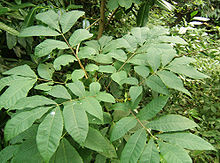Carya
Carya, caria or pecana is a genus of arboreal plants, more rarely shrubby, of the family Juglandaceae. It includes about thirty accepted taxa —among specific, infraspecific and hybrid— of the almost 150 described.
Etymology
carya: derived from the Greek κάρυον, "nut".
Description
Trees, more rarely shrubs, from 3 to 50 meters tall, monoecious like all representatives of the family, with gray or brownish bark, smooth with fissures in young individuals, becoming wrinkled and occasionally deeply furrowed or exfoliated in lamellar scales or in long or wide ribbons. The leaves are imparipinnate, with a glabrous to pubescent or scaly petiole and 3-21 petiolulate leaflets with serrated margins —the largest distal ones— measuring 2-26 by 1-14 cm. The pendulous male catkins have 3 flower fascicles with 3-15 stamens, pubescent or not. The female flowers are arranged in terminal spikes. The fruits are drupaceous ("involved drupe" or "trima") with dehiscent involucre in 4 valves with smooth or winged sutures, with a compressed or not compressed nut, angular or smooth, smooth or warty, skinned thin or thick and brown, occasionally speckled with black or brown. The seed can be sweet or bitter.
Distribution
A dozen species are native to North America (11 in the US, 1 in Mexico), and about 5–6 from China and Indochina. A certain number of species have been introduced in various regions of the world for ornamental, food or industrial purposes.
Species and classification
- See: Annex: species of the genus Carya (Juglandaceae)
- Asia
- Carya Section Sinocarya – Asian Pacanas
- For example:
- Carya cathayensis Sarg.
- Carya dabieshanensis M.C. Liu (can be synonymous with C. cathayensis)
- Carya hunanensis W.C.Cheng & R.H.Chang
- Carya kweichowensis Kuang " A.M.Lu
- Carya poilanei Leroy
- Carya tonkinensis Lecomte
- North America
- Carya Section Carya – Typical Pacanas
- For example:
- Flora carya Sarg.
- Carya glabra Sweet.
- Carya myristiciformis (F.Michx.) Nutt.
- Carya ovalis (Wangenh.) Sarg. (treated as a synonym for C. glabra for Flora N. Amer.)
- Carya ovata (Mill.) K.Koch
- Carya ovata var. ovata
- Carya ovata var. australis (no. C. carolinae-septentrionalis)
- Carya lacinas (Mill.) K.Koch
- Carya pallida (Ashe) Engl. & Graebn.
- Carya texana Buckley.
- Carya tomentosa (Poir.) Nutt. (no. C. alba)
- Carya Section Apocarya – Pacanas
For example:
- Aquatic carya (F.Michx.) Nutt.
- Carya cordiformis (Asch.) Graebn.
- Carya illinoensis K.Koch "pacana"
- Carya palmeri W.E. Manning – Mexican Hickory
Uses
The genus is of some economic importance: for example, Carya illinoinensis, the pecan and its fruit the pecan, is the most important native producer of "nuts" in North America, and the wood of true pecans. "American Walnut" is unmatched for the manufacture of tool handles and golf clubs for its strength and resistance to shock. Pecans are also a good food source for wildlife and are highly valued in human gastronomy. In addition, pecan wood is quite popular in barbecues in the United States and other countries, being frequently used in smoking meats, known for giving a characteristic touch of aroma and flavor when burning while cooking the meat.
On the other hand, Carya cordiformis, C. glabra and C. ovata are extensively cultivated in central Europe as construction timber.
Contenido relacionado
Cell nucleus
Passalum
Malvales



